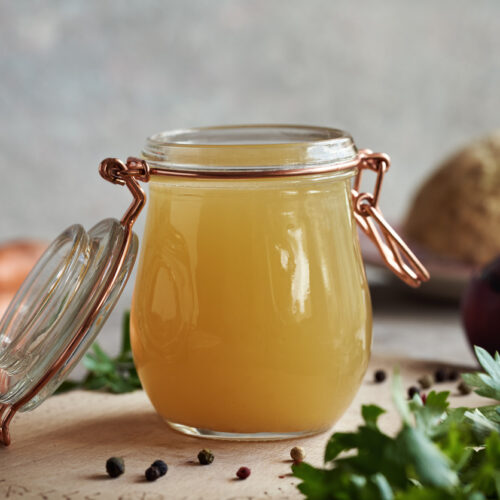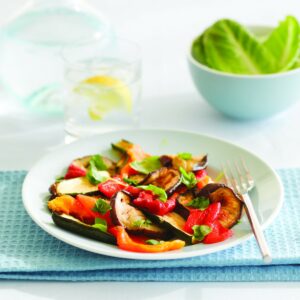
So you want to eat more plant-based foods, but don‘t want to give up your meat? Dietitian Caroline Trickey’s guide to flexitarianism shows you how to make the switch, stay satisfied — and reap the health rewards.
What is flexitarianism?
A plant-based way of eating, flexitarianism focuses on getting most of your nutrients from whole plant foods, leaving room for meat and other animal products if you chose to eat them. Since there are no specific rules, it’s more flexible than fully vegetarian or vegan diets.
Why go plant-based?
Research overwhelmingly shows plant-based eating is good for your heart, brain and gut, and is especially beneficial in terms of ageing healthily. In fact, plant-based eaters are up to 50 per cent less likely to develop age-related chronic diseases such as type 2 diabetes, cancer and heart disease.
Plant-based eating is also a feature of all five ‘Blue Zones’ — regions of the world where people regularly live to over 100 years with few health problems. The traditional Mediterranean diet — a plant-based way of eating consisting mainly of vegetables, legumes, whole grains and fruit, with small portions of lean meat and fish — is associated with better brain and heart health, longevity and reduced risk of cancer.
How to eat more plants
First, get to know the different sources of protein: this will allow you to easily swap between them.
Second, learn how to cook with legumes such as lentils, beans or chickpeas — they’re an easy and versatile plant-based protein source.
Legumes are inexpensive, high in protein and fibre and environmentally friendly.
5 ways to cut back on meat and stay satisfied
1 Become a mindful meat-eater. Move meat from the centre of the plate to the side, and make it no more than a quarter of the meal. When you choose a larger portion like a steak or burger, eat it slowly — and savour every mouthful!
2 Devote half of your lunch and dinner to vegetables or salad, and be creative with how you serve them. When you‘re making a salad, you don’t have to restrict yourself to just lettuce, tomato or cucumber. Why not try rocket or spinach leaves with roasted vegies like pumpkin or capsicum. Add some toasted pinenuts, other nuts or seeds, and crumble over a small amount of feta. Make a super-tasty dressing to drizzle over — one that includes a good quality extra-virgin olive oil mixed with different vinegars, mustards and spices.
3 Focus on variety. Use small amounts of meat, poultry or seafood in a dish, and bulk it out with a can of protein-packed beans or lentils. Many European dishes follow this structure — like cassoulet, the French dish that combines meat with beans. Or harira — Moroccan lamb, tomato and lentil soup — and tagines, which combine meat with vegetables and chickpeas. And don’t forget good old chilli con carne with meat, chillies, tomatoes, spices and beans.
4 You can prepare delicious, tasty meals without meat! Experiment with cooking legumes and tofu. Think dhal, falafels, curries, chillies, various types of vegie burger, or even
a satisfying lentil Bolognese.
5 Adding mushrooms and eggplant to dishes such as Bolognese and to casseroles can help provide a meat-like texture.
Breakfasts
- Homemade or good quality muesli, with dairy or plant-based milk or yoghurt and fruit
- Cooked oats with dairy or plant-based milk, dried fruit, nuts and seeds
- Peanut butter on toast
- Avocado and sliced tomato on wholegrain toast, sprinkled liberally with a mix of seeds
- Baked beans
- Eggs, mushrooms, tomatoes and spinach, on toast or shakshuka
Lunches with 50 per cent veg or salad
- Wholegrain or sourdough sandwiches spread with hoummos and/or avocado, filled with salad or veggies
- Falafels with salad or veggies
- Veggie and lentil or bean-based burger on a wholegrain bun with salad; or veggie and legume patty served with a side of salad or veggies
- Salad loaded with legumes and veggies, with small amounts of cheeses like feta or haloumi
- Soup loaded with legumes and veggies
Dinners with 50 per cent veg or salad
- Try Meatless Monday with tempting meals like chickpea curry, burrito bowls with rice and beans, tofu and vegie stir-fry, and bean and vegie chilli. To boost protein:
- Swap out regular pasta for chickpea or other legume-based pastas, which are loaded with protein
- Add a crunchy protein booster to your meat-free meals by topping them with nuts and/or seeds
- Limit red meat to 200g raw meat per week (two meals of 100g each, or one 200g steak for one meal). Follow the 200g rule for chicken, pork, fish and seafood too.
The bottom line
Overall, the goal of plant-based eating is to eat more nutritious plant foods and less meat. This style of eating is healthier for you and our planet — and it can be filling and delicious too!
Different plant-based diets
Flexitarian means eating mostly plants, most of the time – going vegan means only plants, all of the time.
Some foods containing protein
- Tofu
- Nuts and seeds
- Milk, cheese and yoghurt
- Legumes
- Eggs
- Fish
Article sources and references
- ABC. 2019. Why the Western diet needs to shift to a ‘planetary health diet’ in the age of climate change. Accessed July 2020https://www.abc.net.au/news/2019-01-27/your-healthy-diet-in-the-age-of-climate-change/10750274
- Kahleova, H, et al. 2020. Plant-Based Diets for Healthy Ageing. Journal of the American College of Nutr (ahead-of-print), pp. 1–2https://www.tandfonline.com/doi/abs/10.1080/07315724.2020.1790442
- Crowe F L, et al. 2013. Risk of hospitalization or death from ischemic heart disease among British vegetarians and nonvegetarians: results from the EPIC-Oxford cohort study. Am J Clin Nutr. 97(3): 597–603.https://pubmed.ncbi.nlm.nih.gov/23364007/
- Estruch R, et al. 2018. Primary Prevention of Cardiovascular Disease with a Mediterranean Diet Supplemented with Extra Virgin Olive Oil or Nuts. The New England Journal of Medicine.https://www.nejm.org/doi/full/10.1056/NEJMoa1800389
- Salas-Salvadó J, et al. 2018. Reduction in the incidence of type 2 diabetes with the Mediterranean diet: results of the PREDIMED-Reus nutrition intervention randomized trial. Oct: 41(10): 2259–2260.https://pubmed.ncbi.nlm.nih.gov/20929998/
- Estruch R, et al. 2018. Effects of a Mediterranean-style diet on cardiovascular risk factors: a randomized trial. Ann Intern Med. 145(1): 1–11.https://pubmed.ncbi.nlm.nih.gov/16818923/
- De Lorgeril M, et al. 1999. Mediterranean diet, traditional risk factors, and the rate of cardiovascular complications after myocardial infarction: final report of the Lyon Diet Heart Study. Circulation. 99(6): 779-785.https://www.ahajournals.org/doi/full/10.1161/01.CIR.99.6.779
www.healthyfood.com










